Training for a triathlon in Hawaii is exciting and unique. I follow a flexible plan that includes swimming, biking, and running in different conditions to prepare for Hawaii’s climate and terrain.
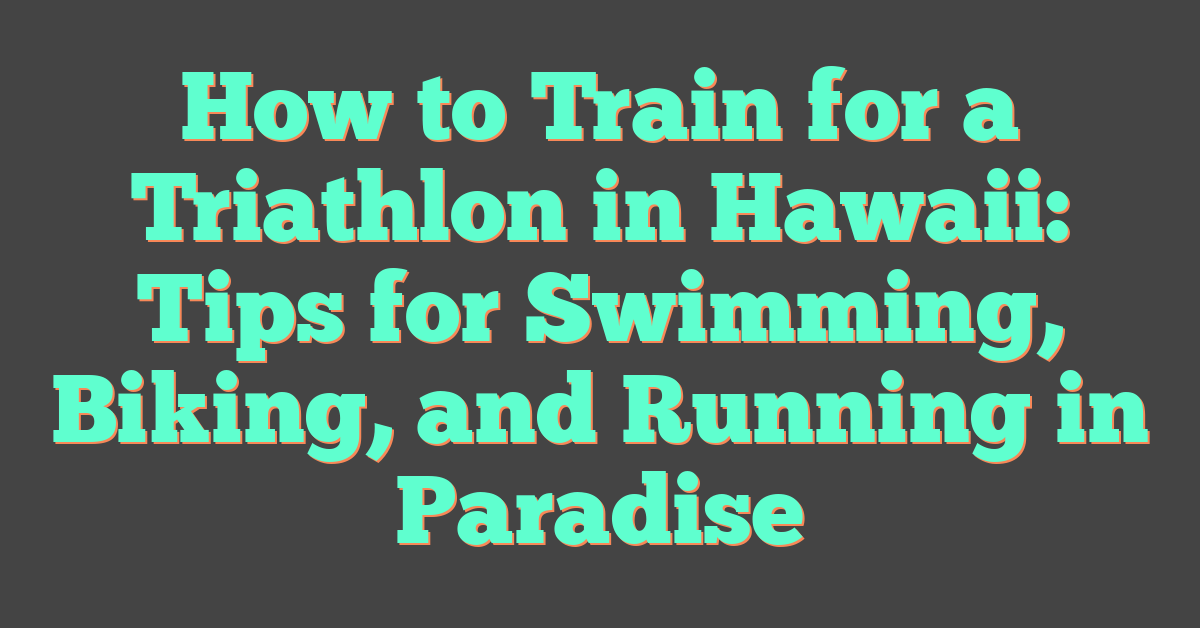
Each training session helps me adjust to warm weather, ocean currents, and hilly courses. I gain confidence by practicing in these settings.
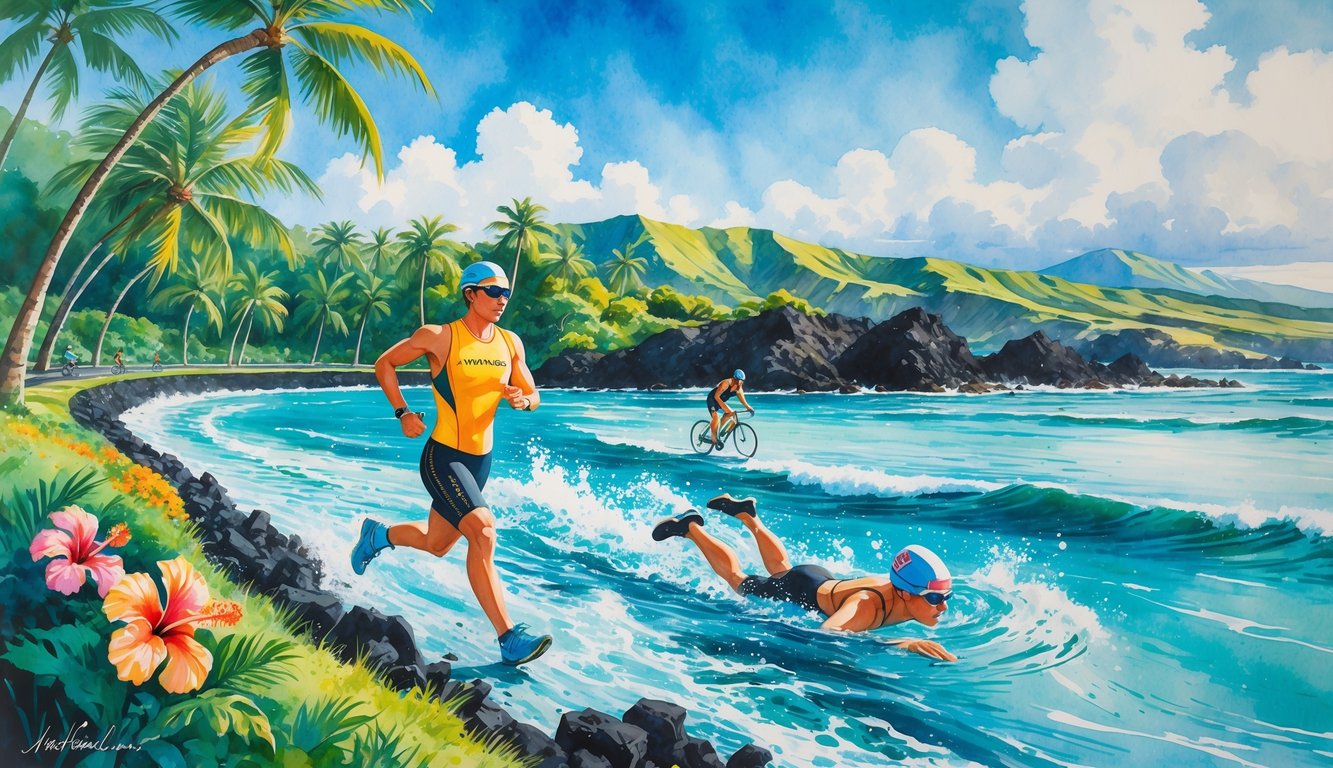
When I join group workouts or local clubs, I find support and motivation from others. Experienced triathletes and certified coaches offer programs that help me improve my skills and build endurance.
I use training plans made for Hawaii, such as those from local triathlon training organizations, to keep my workouts focused and fun.
Understanding Triathlon Training in Hawaii
Living and training in Hawaii gives me special opportunities as a triathlete. Hawaii’s natural conditions, community, and race options shape how I prepare for every event.
The Unique Environment of Hawaii
Hawaii’s weather is warm and humid year-round. I train in heat that can be tough, especially when running long distances.
Trade winds are common, so some bike rides are much harder than others. These winds build my mental toughness for race day.
Steep hills and coastal routes are everywhere. The ocean has big waves and strong currents, so open-water swims always feel different.
Training on the islands changes daily. I adapt my workouts if there’s rain or high surf.
I train at a lower altitude compared to many mainland triathlons. This lets me focus on speed and technique without worrying about thin air.
Hawaii’s landscape always challenges me, and it keeps me motivated for different kinds of races.
Benefits of Training on the Islands
Hawaii’s active triathlon community is a big advantage. Local clubs like Tri Moving and regular group workouts support both beginners and experienced racers.
I get advice from seasoned athletes, including Ironman finishers who know what it takes to succeed. The scenery—beaches, mountains, and palm trees—makes every workout enjoyable.
The weather allows outdoor training almost all year. This consistency helps me improve.
Local events, from fun runs to the Hawaii Ironman in Kona, give me chances to compete with strong athletes. These races push me to work harder and measure my progress.
Different Types of Triathlons
In Hawaii, I can race different distances almost any time of year. The most popular events are sprint triathlons, Olympic distance, half Ironman (70.3), and full Ironman races.
Sprint triathlons are shorter and perfect for new athletes or those with less time. My training for these is more intense but takes less time each week.
Olympic distance races need longer workouts but can fit into a busy schedule. Half Ironman and full Ironman events, like the Kona Ironman, require months of steady progress and planning.
Training plans for longer races can last 20 weeks or more, with detailed schedules for each sport. Local coaches and groups offer personalized plans, so I can pick what fits my goals and experience.
Establishing Your Triathlon Training Plan
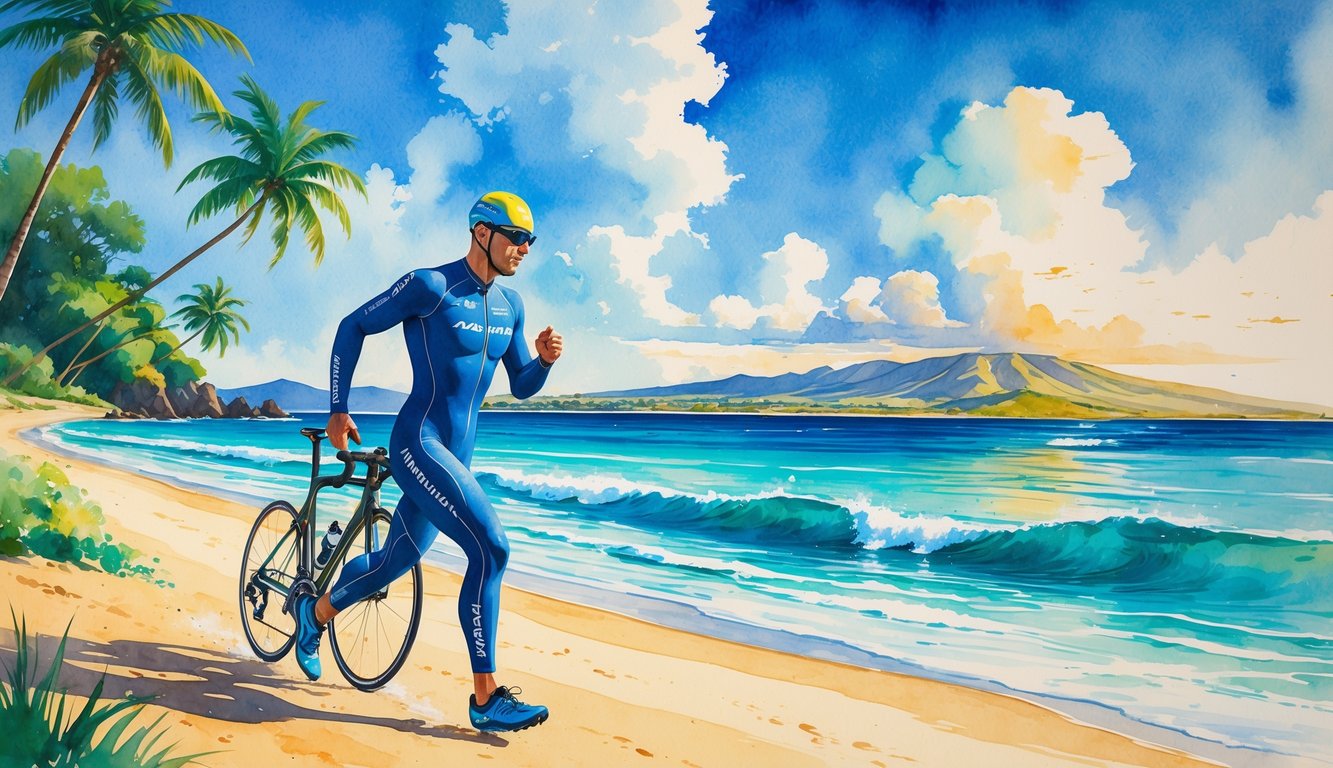
When I started preparing for my Hawaii triathlon, I learned the importance of planning ahead. I set clear goals, found a suitable training program, built a balanced weekly routine, and tracked my progress closely.
Setting Realistic Goals
For my first race, I made sure my goals were realistic. I looked at my current fitness level and thought about how much time I could commit each week.
Hawaii’s humid weather made me plan for heat and longer recovery. I set separate goals for swim, bike, and run segments to make the challenge manageable.
My swim goal was to complete the distance without stopping. On the bike, I aimed to keep a steady pace. For the run, I focused on not walking.
Tip: I keep my early goals simple and trackable, like “run 20 minutes without stopping by week three.” Planning for the local climate and my schedule keeps my goals realistic.
Choosing a Training Program
After setting my goals, I explored different training programs. Some plans are for beginners, while others are for more advanced athletes.
Following a structured plan keeps me motivated and makes workouts easier to manage. Sprint triathlons often have 8-week plans, while Ironman races require at least 20 weeks of structured training.
I compared free plans online and considered hiring a coach. For Hawaii, I picked programs that included open water swims and hill workouts.
I chose a program with recovery days to help prevent injuries. Sometimes I use platforms like TrainingPeaks to schedule and log workouts.
Key factors I look for:
- Program duration
- Workout variety (swim, bike, run, strength)
- Recovery sessions
- Adaptability to Hawaii’s environment
Structuring Your Training Schedule
To build my training schedule, I planned one main workout each day—swim, bike, or run. This helped me balance family, work, and training.
Some weeks included brick workouts where I practiced bike-to-run transitions. I used a calendar or app to organize my sessions.
Each week, my program increased in intensity, but every third or fourth week was lighter for recovery. I trained early in the morning to get used to Hawaii’s humidity and sun.
Here’s a typical week for me:
| Day | Workout |
|---|---|
| Monday | Swim |
| Tuesday | Bike |
| Wednesday | Run |
| Thursday | Off or Easy |
| Friday | Swim |
| Saturday | Bike + Run |
| Sunday | Rest |
Monitoring Progress
I track my progress using a training log and a fitness watch. I write down times, distances, and how I feel after each session.
At the end of each week, I check if my endurance improved or if I managed longer sessions at my goal pace. If I feel tired or sore, I adjust the next week’s schedule.
Tracking my workouts helps me spot patterns, like when I gain endurance or need more recovery. This keeps my training safe and effective, especially with Hawaii’s weather.
Finding Coaching and Community in Hawaii

Having access to knowledgeable coaches and a supportive training group makes triathlon prep more enjoyable. In Hawaii, I can find expert guidance, friendly group workouts, and a strong sense of community.
Expert and Online Coaching Resources
Expert coaching gives me personalized guidance, especially for my first race or if I want to improve my times. Coaches create individualized training plans, analyze my technique, and offer remote check-ins.
USA Triathlon-certified coaches in Hawaii use national standards and up-to-date techniques. Local options like Boca Hawaii offer in-person and online coaching.
Boca Hawaii has a long history of helping both beginners and advanced athletes. Coach Dave Dwan on the Big Island offers coaching and training camps through Big Island Triathlon Adventures.
Group Training and Local Centers
Group training sessions help me stay motivated. Centers like Hawaii Triathlon Center Club and Boca Hawaii organize group training and beginner classes.
These groups meet several times a week and cover all three sports. A typical program might look like this:
| Program Type | Duration | Features |
|---|---|---|
| Adult Beginner Group | 8 weeks | Prepares for Sprint Triathlon |
| Adult Group Training | Varies | Skill-based workouts |
Training with others who share my goals keeps me accountable. Expert coaches lead sessions and help with technique and pacing.
Some centers also offer youth programs, so families can get involved.
Benefits of Camaraderie
Training with others makes workouts more enjoyable. Being part of a club or group helps me push through tough days.
Conversations on long runs and shared laughs in the pool create a sense of belonging. I meet friends, learn from experienced members, and get tips about races and training spots.
Social events and post-workout meetups help build friendships outside of training. Celebrating goals with others, from tough sessions to race finishes, makes the experience more rewarding.
If you’re new in town or want to meet more people, triathlon clubs and group sessions are a great way to connect. Popular groups host events and get-togethers, making the triathlon scene in Hawaii welcoming and inspiring.
You can find groups and clubs through resources like Trifind’s list of Hawaii clubs.
Swim Training for Hawaii Triathlons
Swimming in a Hawaii triathlon means training for open water, not just pool laps. I focus on ocean-specific skills, refine my stroke, and choose the right wetsuit to stay confident and efficient on race day.
Mastering Ocean Swims
Training for Hawaii means getting comfortable in the ocean. I often swim at local beaches, learning how to handle waves, currents, and changing tides.
Practicing sighting is vital. I look up every few strokes to stay on course.
I swim in a group when possible, since race day will be crowded. This helps me get used to bumping elbows and swimming close to others.
To deal with salt water, I rinse my mouth often. I also use anti-chafing balm around my neck and shoulders.
A checklist for my ocean sessions:
- Swim at different times of day to learn about swell changes
- Practice entering and exiting the water
- Wear goggles that don’t fog or leak
- Use a bright swim cap for visibility
For more tips, FORM offers an ocean swim training guide that helps with Hawaii triathlons.
Swim Technique and Drill Workouts
I improve my swimming by mixing focused technique drills with distance sets. Drill workouts help me keep my form strong even when I get tired.
My weekly plan includes pull sets with paddles, kick sets, and drills like fingertip drag or catch-up. These drills refine my stroke.
Speed intervals teach me to maintain effort without burning out early. I use a set like 10x100m at race pace with short rest to practice sustaining my pace.
I also add steady long swims to improve endurance for the full swim distance. I aim for three swims a week.
Following a structured plan, like this 4-week triathlon swim training plan, helps me swim better.
Wetsuit Selection and Preparation
Wetsuit choice matters in Hawaii. I check if my race allows wetsuits since water temperatures can be warm.
If wetsuits are legal, I pick a suit that is flexible in the shoulders. This way, I do not feel restricted while swimming.
I practice with my wetsuit in the ocean before race day. This helps me avoid chafing and get used to how the suit feels.
I also work on quick removal during transitions. A slow change can waste time.
If I do not need a wetsuit, I pick a snug tri suit with a slick surface to help me glide through the water. I always test my gear on long swim days.
This way, I know I will be comfortable and prepared for my Hawaii triathlon swim.
Cycling Preparation and Safety
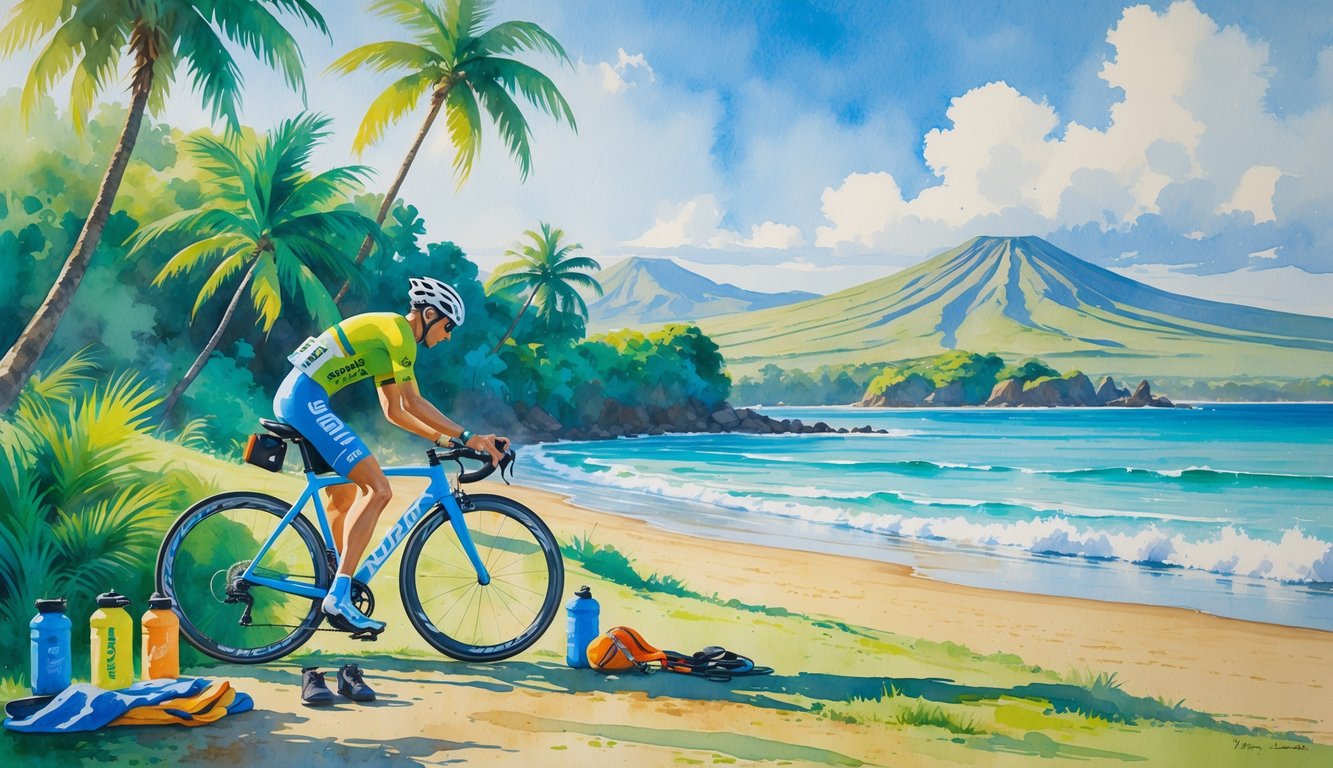
When I train for a triathlon in Hawaii, I prepare for the island’s tough terrain, choose the right bike, and add smart workouts to build strength and endurance. Staying safe and knowing how to handle changing weather is just as important as training hard.
Biking in Hawaii’s Unique Terrain
Hawaii’s landscape is beautiful but demanding for cyclists. I deal with hills, strong winds, and sometimes narrow roads.
The weather can switch fast, so rain gear is useful even on sunny mornings. I always look out for loose gravel and potholes, especially after big storms.
Staying visible is important. I wear bright clothing and add reflectors or lights, even if I’m training during the day.
Local cycling rules matter, like riding single file and using bike lanes when available.
Planning my route helps me avoid busy streets and tourist-heavy areas. If I’m unsure where to ride, I check out group training programs that use safe, popular routes.
Riding with a group makes things safer. I also get good advice about local biking spots.
Choosing the Right Equipment
Picking the correct bike and gear makes a big difference. I select a bike that fits me well, which helps with comfort and prevents injuries.
For Hawaii, a road bike or triathlon bike with good brakes works best. Strong winds can make riding tough, so I use wider tires for more grip.
Here’s a basic equipment checklist:
| Item | Purpose |
|---|---|
| Helmet | Head protection |
| Puncture kit | Quick flat repairs |
| Water bottles | Stay hydrated |
| Sunglasses | Eye protection |
| Bike lights | Visibility in any light |
| Gloves | Better grip and safety |
I check my bike before every ride. I look at tire pressure, brakes, and make sure my chain runs smoothly.
If I’m new to triathlons, I join a cycling clinic to learn more about equipment and safe riding habits.
Interval and Strength Workouts
Interval training helps me boost my speed and endurance. I switch between short, hard efforts and easier riding.
For example, after a warm-up, I pedal hard for 2 minutes, then ride easy for 3 minutes, and repeat this cycle 6-8 times.
I add strength workouts, too. I do bodyweight exercises like squats, lunges, and planks two or three times a week.
These moves make my legs and core stronger. Strong muscles help me handle long rides and steep hills.
To prevent burnout, I mix in recovery rides at a gentle pace. Sometimes, I add hill repeats or endurance training sessions to simulate race day.
I always listen to my body and rest if something feels off. This balanced approach keeps me healthy and ready for the challenge.
Running Strategies for Island Conditions
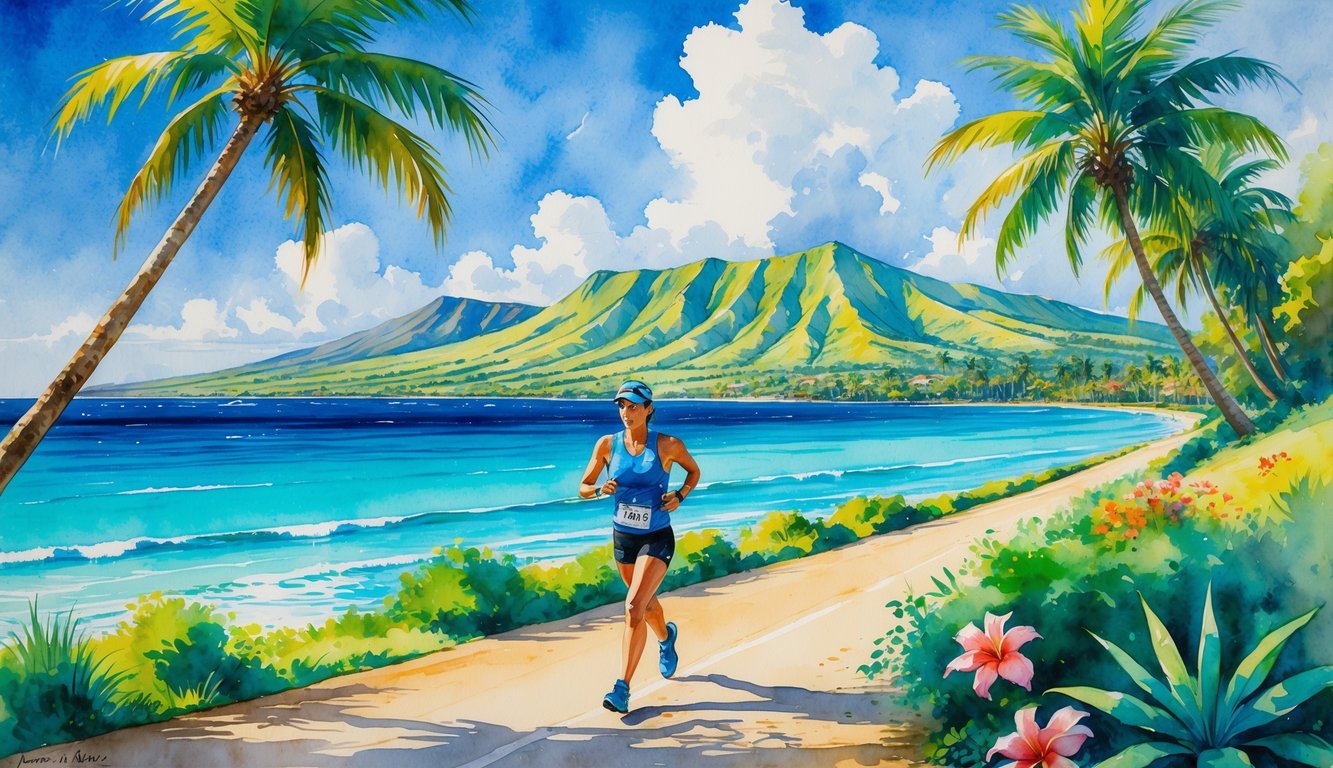
Running in Hawaii means adjusting to the hot, humid air and unpredictable terrain. I pay close attention to weather, shoe choice, and route planning to stay comfortable and safe during each run.
Adapting to Heat and Humidity
I train outside during the warmer parts of the day. This helps my body get used to higher temperature and humidity.
Hydration is a priority. I always bring water or an electrolyte drink.
I look for shaded spots or breezy routes to avoid overheating. Wearing lightweight, moisture-wicking clothes makes a big difference.
Cotton traps sweat and makes me feel too warm, so I choose technical fabrics designed for runners. I run with a cap and sunglasses to limit sun exposure.
Sometimes, I use sunscreen made for sports to avoid sunburn even on cloudy days. Keeping my pace slower when the heat is highest helps me finish the workout without getting sick.
Adaptation takes time, so I add a little heat exposure each week.
Choosing Proper Running Shoes
Running on the Big Island means facing roads, lava rocks, and dirt trails. I select running shoes with solid grip and good cushioning.
This is essential because rough or uneven surfaces can lead to slips or sore feet. I visit shops that let me try on different pairs and test my stride.
I switch out my shoes every 300 to 500 miles since old shoes can cause blisters or injuries. If the forecast calls for rain, I pick shoes with good drainage to avoid soggy feet.
My favorite shoes are lightweight but offer enough support for longer distances. In Hawaii, I prefer shoes with breathable mesh uppers, which help keep my feet cooler and drier.
Planning Long Runs
Planning is key for long runs in Hawaii’s tropical climate. I map out my route before I leave home and look for loops or out-and-back trails with water fountains or convenience stores along the way.
If I’m doing a run longer than an hour, I bring gels or chewable fuel. I plan for a brief stop every 30 to 45 minutes.
If I’m training for a big race like Kona, I practice running on fresher legs after a swim or bike workout to mimic race day fatigue.
I always alert someone about my route and estimated finish time. Carrying my phone or GPS watch helps with safety and lets me track my pace and hydration needs.
Nutrition and Hydration Essentials
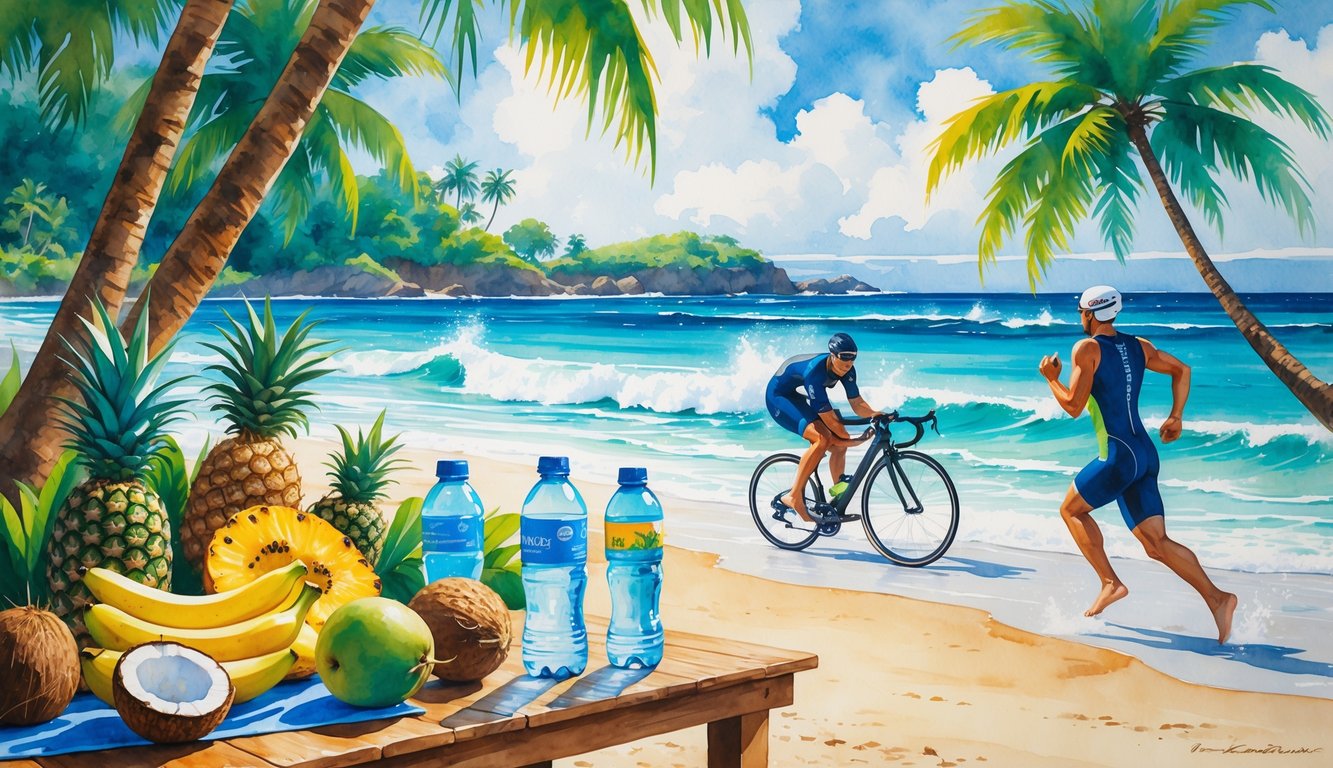
To perform well in a triathlon in Hawaii, I focus on eating the right foods and drinking plenty of fluids. The hot and humid weather makes these essentials even more important for my health and wellness.
Creating a Balanced Diet
I always make sure my meals have a mix of carbohydrates, lean proteins, and healthy fats. Carbohydrates give me energy for training, so I eat foods like brown rice, sweet potatoes, and whole grain pasta.
Lean protein from fish, chicken, tofu, or beans helps build muscle and supports recovery. Fresh fruits and vegetables give me vitamins, minerals, and antioxidants.
Since Hawaii has lots of local produce, I enjoy bananas, mangos, and leafy greens daily. I avoid heavy, greasy foods because they can slow me down or upset my stomach.
For snacks, I pick options that are easy to digest such as bananas, energy bars, or peanut butter on toast. During longer bike rides or runs, I choose simple carbs like energy chews or stroopwafels to keep my energy up.
Hydration for Tropical Climates
The heat in Hawaii means I sweat a lot during workouts, so I pay close attention to my fluid intake. I drink water throughout the day, not just when I’m thirsty.
Before training, I drink about 16 ounces of water. During exercise, I try to drink 5 to 10 ounces of water every 20 minutes.
For workouts longer than an hour, I use a sports drink with electrolytes like sodium and potassium. This helps replace what I lose when I sweat.
I check my urine color; pale yellow tells me I’m well hydrated. After training, I rehydrate with both water and a recovery drink.
I use a guide for fluid intake based on my body weight and how much I sweat.
Supplements and Recovery Fuels
Sometimes I find it hard to get all my nutrients from whole foods, especially after hard workouts. I add a simple protein shake to help my muscles recover.
I use whey, plant-based, or egg white protein depending on what feels best for my stomach. Electrolyte tablets or powders help me stay balanced after long training days, especially when I train in the sun.
I keep recovery snacks easy—like chocolate milk or a homemade smoothie with fruit and yogurt. I eat or drink something within 30 to 60 minutes after exercise to support muscle recovery and wellness.
If I consider supplements, like a multivitamin or omega-3, I talk with my doctor first to stay healthy and safe.
Perfecting Transitions and Race Day Preparation
When I train for a triathlon in Hawaii, I focus not just on the swim, bike, and run but also on the small details that keep me moving fast and smooth. Good transitions, smart packing, and local racing strategies matter for feeling ready and confident.
Efficient Transitions
Getting through T1 and T2 quickly can cut minutes off my final time. I always lay my gear out in the order I’ll need it.
For the swim-to-bike transition, I line up my helmet, sunglasses, and bike shoes. After the bike, I set my running shoes and race bib within easy reach.
I practice these steps over and over to move on autopilot under race pressure. When I practice at home or in a local sprint triathlon, I even time myself.
This lets me fix mistakes before race day. I check the race map and walk through each area if possible, especially for point-to-point courses.
Hawaii 70.3 events sometimes use split transitions, so knowing the layout helps me spot my bike or running shoes quickly. I never second-guess where to go when I’m familiar with the setup.
Race Day Packing and Logistics
I use a printed checklist so I never forget essentials like my timing chip, gels, goggles, and socks. Hawaii’s weather can change fast, so I pack sunblock, a hat, and extra fluids every time.
Travel between islands or to remote race sites makes logistics in Hawaii tricky. I set out my clothes and nutrition the night before.
I double-bag my gear in case of rain on race morning. For bigger events like the Hawaii 70.3, I check if there are shuttles or early check-in requirements.
I confirm start times, parking info, and how my family will find me after the finish. Simple plans help me stay calm if anything unexpected happens.
Racing Strategy in Hawaii
Humidity and sun in Hawaii change how I race. I drink more water and watch my electrolyte intake.
I avoid pushing too hard on the opening swim or bike segments. I always study the course map for shaded sections, hills, or exposed roads.
If winds pick up, I lower my effort on the bike to save energy for the run. For local sprint triathlons, I go out fast but listen to my body.
For longer races like the Hawaii 70.3, I pace myself and cool off at aid stations. I stick to my plan but stay flexible if conditions change.
Injury Prevention, Recovery, and Wellness
Training for a triathlon in Hawaii means focusing on more than just endurance and speed. I put a lot of effort into keeping my body healthy, preventing injuries, and recovering well so I can train consistently and enjoy my workouts.
Stretching and Mobility
Every session, I make time to stretch before and after training. Warm-up stretches help wake up my muscles and increase blood flow.
After workouts, I use gentle stretching to lower muscle tightness and reduce my injury risk. For mobility, I add daily exercises with bands or my own bodyweight, such as lunges, leg swings, and arm circles.
These moves help my hips and shoulders stay loose, which is important for swimming and biking. I sometimes use a foam roller for my legs and back, especially after hard runs or long rides, to work out knots and boost blood flow.
Each week, I check in with how my joints and muscles feel. Consistent stretching and mobility routines make my workouts more comfortable and help me avoid nagging issues.
Personalized Testing and Analysis
To avoid missing hidden weaknesses, I ask a physical therapist to check my movement patterns. This process finds muscle imbalances or tight spots that could cause problems.
A professional points out specific stretches or strength exercises for those areas. You can find more about injury-risk assessments in this USA Triathlon injury prevention checklist.
I also track my progress with a fitness watch or other devices that monitor my heart rate and recovery. Checking my data helps me see if I’m pushing too hard or not recovering enough.
Personalized analysis keeps my training on track. It gives me feedback on what’s working and what needs to change.
Rest and Active Recovery Techniques
I schedule full rest days and plan lighter training weeks every month. Without time off, my risk for injuries goes up and my performance drops.
On “off” days, I sometimes do easy swims, slow bike rides, or yoga to boost blood flow without adding stress. Good sleep is one of my top priorities.
I go to bed at the same time each night and aim for at least 7-8 hours. I stay hydrated and eat foods rich in protein and other nutrients to help muscle repair.
For more on nutrition’s role in injury prevention, I check guides like this one on essential tips for triathlon training injuries. By using active recovery and tracking my wellness, I feel better after hard workouts and avoid overtraining.
Getting the Most Out of Triathlon Events in Hawaii
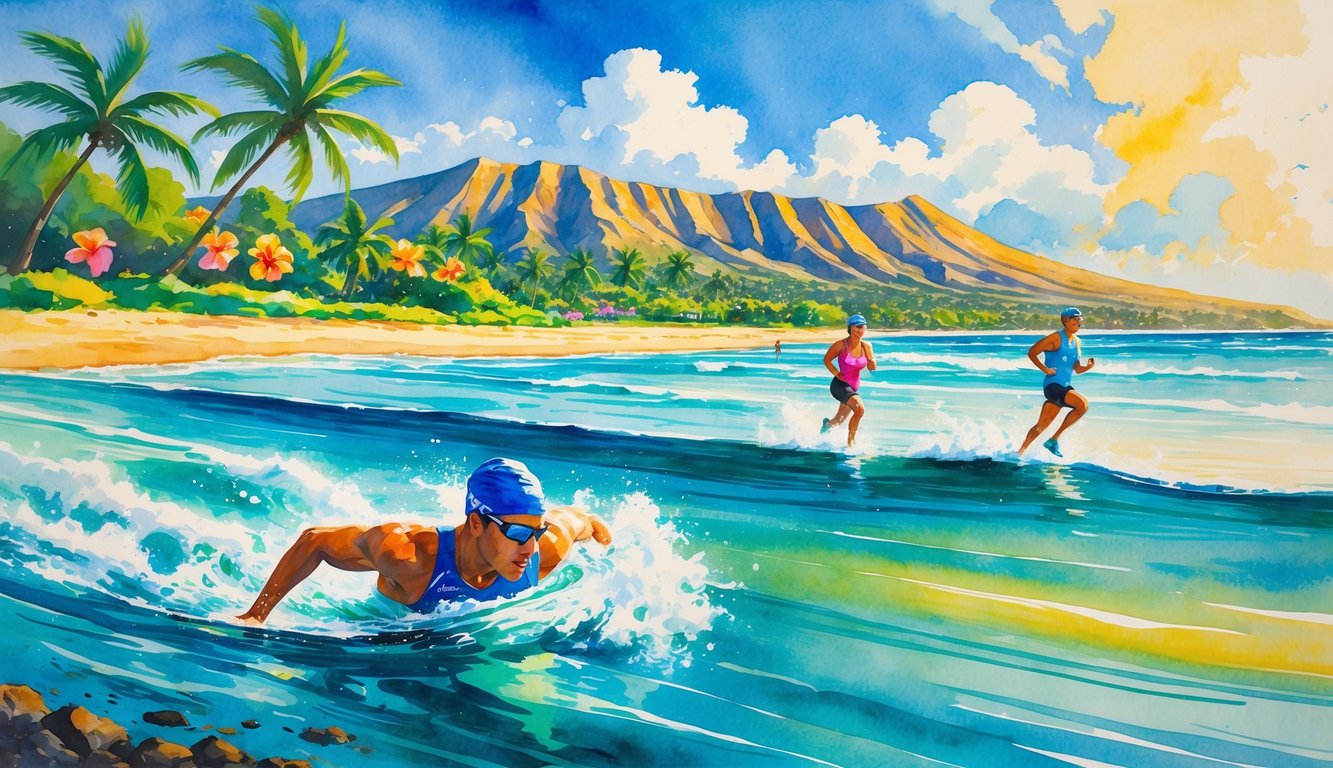
Joining triathlon events in Hawaii is both exciting and challenging. By choosing the right camps, taking part in famous local races, and keeping my motivation strong after races, I get the most out of my experience.
Participating in Training Camps
When I wanted to boost my skills, I signed up for a local training camp. These camps are common across Hawaii, from Oahu to the Big Island.
Many are open to beginners, such as the New 2 Tri camps, and also welcome advanced athletes. Training camps usually cover swimming, biking, and running with guidance from experienced coaches.
It helped me get immediate feedback and advice. I joined group practices, which made training less lonely and pushed me to improve.
Some camps, like those at Boca Hawaii, offer year-round programs next to well-equipped bike shops. They welcome everyone and provide a community feel.
The support from coaches and other participants kept me on track. For more about year-round training programs, I found helpful info on the Honolulu Triathlon training page.
Exploring Local and Iconic Races
Signing up for races in Hawaii lets me experience local culture. The most famous triathlon is the Ironman in Kona, which brings together athletes from around the world.
Even if I am not ready for this elite event, many other local races across Hawaii’s islands have welcoming atmospheres. I found small races perfect for beginners through community clubs and race organizers.
Kona and other locations often have group rides and run days set up by clubs, which helped me meet other athletes. Big Island Running and Kona Aquatics organize regular events where I could compete or practice in a friendly environment.
I checked local listings and learned about the triathlete life in Kona to plan my race calendar.
Staying Motivated Post-Event
After a big event, staying motivated can be tough.
I set new goals right away to keep myself on track.
I joined local group training programs, which gave me a reason to keep showing up.
Clubs like the Hawaii Triathlon Center Club welcomed me and made me feel part of a team.
Camps and clubs often plan year-long schedules and social activities.
These activities helped me connect with other athletes, even when I wasn’t training hard.
When I doubted myself, I remembered how good it felt to cross the finish line.
I used easy payment options like PayPal to quickly sign up for my next event or camp at places like the Hawaii Triathlon Center.
This helped me stay motivated to keep training and improving.




